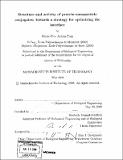| dc.contributor.advisor | Kimberly Hamad-Schifferli. | en_US |
| dc.contributor.author | Aubin-Tam, Marie-Eve | en_US |
| dc.contributor.other | Massachusetts Institute of Technology. Dept. of Biological Engineering. | en_US |
| dc.date.accessioned | 2010-04-28T17:18:42Z | |
| dc.date.available | 2010-04-28T17:18:42Z | |
| dc.date.copyright | 2008 | en_US |
| dc.date.issued | 2008 | en_US |
| dc.identifier.uri | http://hdl.handle.net/1721.1/54676 | |
| dc.description | Thesis (Ph. D.)--Massachusetts Institute of Technology, Dept. of Biological Engineering, 2008. | en_US |
| dc.description | Cataloged from PDF version of thesis. | en_US |
| dc.description | Includes bibliographical references (p. 130-145). | en_US |
| dc.description.abstract | Nanoparticle-protein conjugates have a variety of applications in imaging, sensing, assembly and control. The nanoparticle-protein interface is made of numerous complex interactions between protein side-chains and the nanoparticle surface, which are likely to affect protein structure and compromise activity. Ribonuclease S and cytochrome c are covalently linked to nanoparticles via attachment to a specific surface cysteine, with the goal of optimizing protein structure and activity, and understanding conditions that minimize non-specific adsorption. Protein behavior is explored as a function of the nanoparticle surface chemistry and material, the density of proteins on the nanoparticle surface, and the position of the labeled site. Ribonuclease S is attached to Au nanoparticles by utilizing its two-piece structure. Enzymatic activity is determined using RNA substrate with a FRET pair. Conjugation lowers the ribonucleatic activity, which is rationalized by the presence of negative charges and steric hindrance which impede RNA in reaching the active site. Cytochrome c is linked to Au and CoFe204 nanoparticles. The protein is denatured when the nanoparticle ligands are charged, but remains folded when neutral. The presence of salt in the buffer improves folding. This indicates that electrostatic interactions of charged amino acids with the charged ligands are prone to lead to protein denaturation. The attachment site can be controlled by mutations of surface residues to cysteines. Protein unfolding is more severe for nanoparticle attached in the vicinity of charged amino acids. Molecular dynamics simulations of the conjugate reveal that electrostatic interactions with· the nanoparticle ligand lead to local unfolding of [alpha]-helices of cyt c. Furthermore, the nanoparticle induces more structural disturbance when it is attached on the N- and C-terminal [alpha]-helices foldon, which is the most stable motif of cyt c and the most essential for folding. | en_US |
| dc.description.statementofresponsibility | by Marie-Eve Aubin-Tam. | en_US |
| dc.format.extent | 145 p. | en_US |
| dc.language.iso | eng | en_US |
| dc.publisher | Massachusetts Institute of Technology | en_US |
| dc.rights | MIT theses are protected by copyright. They may be viewed, downloaded, or printed from this source but further reproduction or distribution in any format is prohibited without written permission. | en_US |
| dc.rights.uri | http://dspace.mit.edu/handle/1721.1/7582 | en_US |
| dc.subject | Biological Engineering. | en_US |
| dc.title | Structure and activity of protein-nanoparticle conjugates: towards a strategy for optimizing the interface | en_US |
| dc.type | Thesis | en_US |
| dc.description.degree | Ph.D. | en_US |
| dc.contributor.department | Massachusetts Institute of Technology. Department of Biological Engineering | |
| dc.identifier.oclc | 607355696 | en_US |
